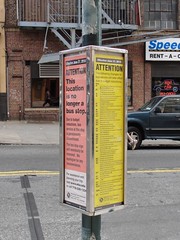 Unless the U.S. Senate can deliver operating aid to the MTA before late June, the city will suddenly find itself with hundreds of empty bus stops and vacant curbside space. While the MTA oversees the buses and their drivers, New York City’s Department of Transportation is in charge of the street space and the bus shelters. What will they do with the 570 unused stops?
Unless the U.S. Senate can deliver operating aid to the MTA before late June, the city will suddenly find itself with hundreds of empty bus stops and vacant curbside space. While the MTA oversees the buses and their drivers, New York City’s Department of Transportation is in charge of the street space and the bus shelters. What will they do with the 570 unused stops?
Streetsblog’s Noah Kazis tackled just this question yesterday. He notes first that “any plan to re-purpose bus stops will be provisional, since the cuts might be averted or service could be restored at a later date” and urges New York City to look west to San Francisco for ways to “promote sustainable transportation and improve the quality of public space.”
The obvious use for these bus stop spaces would include bike parking both underneath the shelters and perhaps in the streets. San Francisco has used the curbside space at former bus stops for either on-street bike parking or mini plazas. Considering how many bus stops are in business-rich and pedestrian-friendly neighborhoods that rely on foot traffic and will soon be suffering with public transit, the bike spaces could go a long way toward maintaining a vibrant street life in the absence of buses.
Yet, reports Kazis, NYC DOT isn’t thinking that far outside of the box. He says:
Here in New York City, it looks like DOT’s contingency plan does not include re-purposing street space for pedestrian or bike improvements.
At most closed-down bus stops, said an agency spokesperson, the curbside area will simply take on the regulations of the adjoining area. If the street has parking along the curb, for example, the bus stop will become parking. In a few cases, the bus stop might be used for something like a truck loading zone instead.
Advocates are calling for DOT to think creatively about this new space, if the need arises. “Every neighborhood is different and there’s definitely no cookie-cutter solution for all of these bus stops,” said Transportation Alternatives’ Wiley Norvell, but in many neighborhoods, the curbside area could be used “to create green space or open space for leisure and recreation.” While TA’s goal is to ultimately see bus service restored, said Norvell, “we really hope that the city is using the biggest possible toolbox when reprogramming the space.”
Other transit advocates believe DOT could be missing a golden opportunity to do anything with the new parking spaces and public areas. A writer who goes by the pseudonym Chicken Underwear and lives near the intersection across the street from my apartment which will soon lose two bus stops along the B71 route believes the city should charge higher rates for the premium spaces that were once bus stops. He wants to see the city charge $5 during the day and maybe $2 at night for these spaces, thus maintaining high turnover and ensuring that people who want to shop in the area and insist on driving can park.
Higher parking rates would have an added benefit as well. As I wrote last year, the MTA could draw in a lot of money if New York City were to charge market rates for its parking spots. This money could offset some of the service cuts or help the MTA alleviate the remainder of its debt, and in time, it could be used to restore service along corridors that need it.
For now, we have to hope that the cuts are temporary. We have to hope someone somewhere with political sway can find the will and the dollars to avoid a transit reduction that will harm the city’s economy. But if the cuts come to pass in a little over a month, DOT shouldn’t waste a valuable opportunity to repurpose some empty spaces.

7 comments
Since most roadways fall under the jurisdiction of NYCDOT, wouldn’t turning these stops into parking and collecting revenue from them go directly to their coffers rather than the MTA’s?
It don’t really matter to me who get the money from the parking meters at the old bus stops. Just as long as we don’t get anymore “free” parking in my neighborhood. We got enough cars already.
I think my landlord is already celebrating the demise of the bus stop in front of our building as more parking for his hearses. (I’m guessing that since he parks in the bus stop habitually, even before the cuts.)
I hope your landlord is smart enough to be cautious, as he sounds happy that no more buses will serve his neighborhood and funeral home for now (I assume that is what you’re referring to).
[…] of these spaces. The road space will probably revert to below-market parking spots when they should become areas for bike parking. The CEMUSA shelters might remain as on-street advertising and semi-useful street furniture. […]
[…] of unused curb space it now has at its disposal. I’m holding out hope for some combination of bike storage areas, mini green spaces and market-rate on-street parking spots. Categories : Asides, […]
[…] with livable streets advocates in calling for the city’s Department of Transportation to turn former bus stops in bike parking spaces, among other non-auto-centric uses. When the NYPD, however, told its enforcement agents to avoid […]